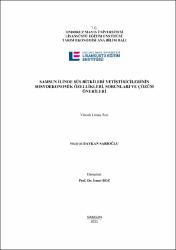Samsun ilinde süs bitkileri yetiştiricilerinin sosyoekonomik özellikleri, sorunları ve çözüm önerileri
Künye
Sarıoğlu, N.B. (2021). Samsun ilinde süs bitkileri yetiştiricilerinin sosyoekonomik özellikleri, sorunları ve çözüm önerileri. (Yüksek lisans tezi). Ondokuz Mayıs Üniversitesi, Samsun.Özet
Bu tez; Samsun ilinde süs bitkileri yetiĢtiriciliği yapan iĢletmelerin sorunlarını ortaya koymak ve bu sorunlara uygun çözüm önerileri bulmak amacıyla yapılmıĢtır. AraĢtırmanın materyalini, tam sayım yöntemine göre süs bitkileri üretim ve pazarlaması yapan ve sadece pazarlama yapan iĢletmelerle Samsun iline bağlı 6 ilçede bulunan 55 iĢletme ile yüz yüze görüĢülerek anket çalıĢması ile elde edilen veriler oluĢturulmuĢtur. Veriler Ekim-Kasım 2020 döneminde toplanmıĢtır. AraĢtırmada veri analizinde seçilen yöntemler araĢtırma amaçları doğrultusunda belirlenmiĢtir. Bu amaçla üretim ve pazarlama yapan iĢletmeler ile sadece pazarlama yapan iĢletmeler arasında sosyoekonomik özellikleri ve iĢletme özellikleri arasında herhangi bir farklılık olup olmadığı Fisher testi ve Ki-Kare testi ile kontrol edilmiĢtir. AraĢtırma bulgularına göre, süs bitkileri sektöründe faaliyet gösteren katılımcıların ortalama yaĢı %42.6, iĢletme yaĢı ortalaması 14.5‟tir. ĠĢletmeler %92.7 oranında Ģahıs iĢletmesidir. ĠĢletmelerin ağırlıklı olarak faaliyet gösterme durumu %69.1 iç mekan, %50.9 dıĢ mekan, %50.9 kesme çiçektir. ĠĢletmelerin süs bitkileri sektöründe karĢılaĢtıkları sorunlar %67.3 iĢgücü temini sorunu, %45.5 enerji sorunudur. En önemli pazarlama problemi beĢli Likert ölçeğine göre ölçülen ve ortalaması 4.45 olarak bulunan üretim maliyetinin fazla olmasıdır. ĠĢletmeciler sektöre iliĢkin güçlü ve zayıf yönleri, fırsatları, tehditleri söyleyerek mevcut durumun ortaya konulması ve stratejiler geliĢtirilmesine olanak sağlanması açısından SWOT Analizi Yöntemi ile analiz edilmiĢtir. AraĢtırmada uygulanan Fisher ve Ki-Kare testi sonuçlarına göre üretim ve pazarlama yapan iĢletmelerle sadece pazarlama yapan iĢletmeler arasında sosyoekonomik açıdan herhangi bir farklılık görülmemiĢtir fakat iĢletme özellikleri olarak bakıldığında arazi varlığı, iĢletmelerin ağırlıklı olarak faaliyet gösterme durumu, kullanılan alan bilgileri farklılık göstermektedir. This thesis was carried out in order to reveal the problems of the enterprises that grow ornamental plants in Samsun and to find suitable solutions for these problems. The material of the research consisted of information provided by face-toface interviews conducted with a sample of 55 enterprises that produce and market ornamental plants in 6 districts of Samsun province. Data were collected in the period of October-November 2020. The methods chosen in data analysis in the research were determined in line with the research objectives. For this purpose, it was checked by Fisher test and the Chi-square test whether there is any difference between the socioeconomic characteristics and business characteristics between the companies engaged in production and marketing and those that only do marketing. According to the research findings, the average age of the participants operating in the ornamental plants sector is 42.6% and the average age of the enterprise is 14.5%. Businesses are 92.7% sole proprietorships. Predominantly operating status of businesses is 69.1% indoor, 50.9% outdoor, 50.9% cut flower. The problems faced by the enterprises in the ornamental plants sector are 67.3% labor supply problem and 45.5% energy problem. The most important marketing problem was the high production costs with a mean of 4.45, measured in a five-point Likert scale. The operators were analyzed with the SWOT Analysis Method in order to reveal the current situation and develop strategies by stating the strengths and weaknesses, opportunities and threats related to the sector. According to the results of the Fisher and Chi-Square test applied in the research, no socioeconomic difference was observed between the companies engaged in production and marketing, and those engaged in marketing only, but when it is considered as business characteristics, the land presence, the predominantly operating status of the enterprises, and the field information used differ.
















